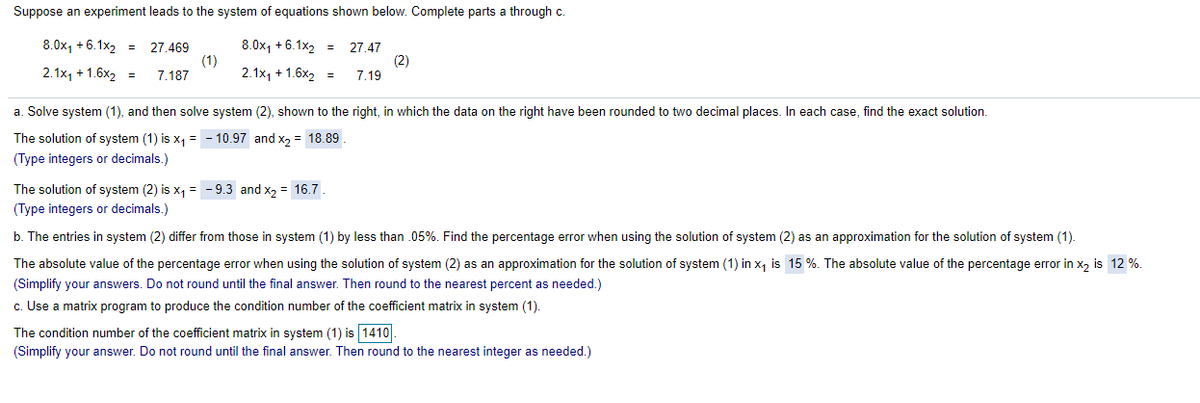Suppose an experiment leads to the system of equations shown below. Complete parts a through c. 8.0x, +6.1x2 = 8.0x, +6.1x2 27.469 (1) 7.187 27.47 (2) 7.19 %3D 2.1x, + 1.6x2 = 2.1x, + 1.6x2 = a. Solve system (1), and then solve system (2), shown to the right, in which the data on the right have been rounded to two decimal places. In each case, find the exact solution. The solution of system (1) is x, = - 10.97 and x2 = 18.89. Type integers or decimals.) The solution of system (2) is x, = - 9.3 and x2 = 16.7. Type integers or decimals.) b. The entries in system (2) differ from those in system (1) by less than .05%. Find the percentage error when using the solution of system (2) as an approximation for the solution of system (1). The absolute value of the percentage error when using the solution of system (2) as an approximation for the solution of system (1) in x, is 15 %. The absolute value of the percentage error in x, is 12 %. (Simplify your answers. Do not round until the final answer. Then round to the nearest percent as needed.) c. Use a matrix program to produce the condition number of the coefficient matrix in system (1). The condition number of the coefficient matrix in system (1) is 1410. (Simplify your answer. Do not round until the final answer. Then round to the nearest integer as needed.)
Suppose an experiment leads to the system of equations shown below. Complete parts a through c. 8.0x, +6.1x2 = 8.0x, +6.1x2 27.469 (1) 7.187 27.47 (2) 7.19 %3D 2.1x, + 1.6x2 = 2.1x, + 1.6x2 = a. Solve system (1), and then solve system (2), shown to the right, in which the data on the right have been rounded to two decimal places. In each case, find the exact solution. The solution of system (1) is x, = - 10.97 and x2 = 18.89. Type integers or decimals.) The solution of system (2) is x, = - 9.3 and x2 = 16.7. Type integers or decimals.) b. The entries in system (2) differ from those in system (1) by less than .05%. Find the percentage error when using the solution of system (2) as an approximation for the solution of system (1). The absolute value of the percentage error when using the solution of system (2) as an approximation for the solution of system (1) in x, is 15 %. The absolute value of the percentage error in x, is 12 %. (Simplify your answers. Do not round until the final answer. Then round to the nearest percent as needed.) c. Use a matrix program to produce the condition number of the coefficient matrix in system (1). The condition number of the coefficient matrix in system (1) is 1410. (Simplify your answer. Do not round until the final answer. Then round to the nearest integer as needed.)
Linear Algebra: A Modern Introduction
4th Edition
ISBN:9781285463247
Author:David Poole
Publisher:David Poole
Chapter2: Systems Of Linear Equations
Section2.2: Direct Methods For Solving Linear Systems
Problem 2BEXP
Related questions
Question

Transcribed Image Text:Suppose an experiment leads to the system of equations shown below. Complete parts a through c.
8.0x, +6.1x2 =
8.0x, +6.1x2 =
27.469
(1)
7.187
27.47
(2)
7.19
2.1x1 + 1.6x2 =
2.1x1 + 1.6x2 =
a. Solve system (1), and then solve system (2), shown to the right, in which the data on the right have been rounded to two decimal places. In each case, find the exact solution.
The solution of system (1) is x, = - 10.97 and x2 = 18.89
(Type integers or decimals.)
The solution of system (2) is x, = - 9.3 and x2 = 16.7
(Type integers or decimals.)
b. The entries in system (2) differ from those in system (1) by less than .05%. Find the percentage error when using the solution of system (2) as an approximation for the solution of system (1).
The absolute value of the percentage error when using the solution of system (2) as an approximation for the solution of system (1) in x, is 15 %. The absolute value of the percentage error in x, is 12 %.
(Simplify your answers. Do not round until the final answer. Then round to the nearest percent as needed.)
c. Use a matrix program to produce the condition number of the coefficient matrix in system (1).
The condition number of the coefficient matrix in system (1) is 1410.
(Simplify your answer. Do not round until the final answer. Then round to the nearest integer as needed.)
Expert Solution
This question has been solved!
Explore an expertly crafted, step-by-step solution for a thorough understanding of key concepts.
This is a popular solution!
Trending now
This is a popular solution!
Step by step
Solved in 2 steps

Knowledge Booster
Learn more about
Need a deep-dive on the concept behind this application? Look no further. Learn more about this topic, calculus and related others by exploring similar questions and additional content below.Recommended textbooks for you

Linear Algebra: A Modern Introduction
Algebra
ISBN:
9781285463247
Author:
David Poole
Publisher:
Cengage Learning

Algebra for College Students
Algebra
ISBN:
9781285195780
Author:
Jerome E. Kaufmann, Karen L. Schwitters
Publisher:
Cengage Learning

College Algebra
Algebra
ISBN:
9781305115545
Author:
James Stewart, Lothar Redlin, Saleem Watson
Publisher:
Cengage Learning

Linear Algebra: A Modern Introduction
Algebra
ISBN:
9781285463247
Author:
David Poole
Publisher:
Cengage Learning

Algebra for College Students
Algebra
ISBN:
9781285195780
Author:
Jerome E. Kaufmann, Karen L. Schwitters
Publisher:
Cengage Learning

College Algebra
Algebra
ISBN:
9781305115545
Author:
James Stewart, Lothar Redlin, Saleem Watson
Publisher:
Cengage Learning

Algebra and Trigonometry (MindTap Course List)
Algebra
ISBN:
9781305071742
Author:
James Stewart, Lothar Redlin, Saleem Watson
Publisher:
Cengage Learning

Algebra: Structure And Method, Book 1
Algebra
ISBN:
9780395977224
Author:
Richard G. Brown, Mary P. Dolciani, Robert H. Sorgenfrey, William L. Cole
Publisher:
McDougal Littell

Elementary Linear Algebra (MindTap Course List)
Algebra
ISBN:
9781305658004
Author:
Ron Larson
Publisher:
Cengage Learning